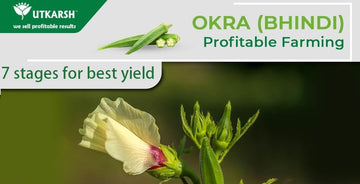
Okra Farming or lady finger Farming is the most popular one as it is one of the most healthy and loved vegetables all across India. It is a rich source of protein, vitamins, calcium and minerals.
Okara Farming happens in almost all the Indian states but the majority of production happens in Gujarat, West Bengal, Bihar and Madhya Pradesh.
The three main planting seasons when okra farming happens is during February-April, June-July and October-November.
Okra Farming: Climate and soil
A warm climate is best for growing Okra and during the harvest, a temperature of 25 to 35 degrees celsius is recommended.
Okra is adaptable to many soils but the most ideal soil for growing it is sandy to clay loam with good drainage facility and organic matter. It can also grow in heavy soils if proper drainage is available. The pH of the soil should be from anywhere between 6.0 to 6.5.
It is recommended not to plan okra farming in alkaline or saline soils as they are soils that have poor drainage capacity.
Okra Farming: The recommended fertigation schedule

BEFORE SOWING:
The soil needs to be fertilized before sowing of the seeds so that the seeds can get the proper nutrition and grow healthy before starting Okra Farming.
For that, MARVELZ-G of 10 kg/litre that is a natural, organic and biological growth promoter should be used.
 OKRA FARMING: SOWING TO PLANT ESTABLISHMENT STAGE:
OKRA FARMING: SOWING TO PLANT ESTABLISHMENT STAGE:
This stage is divided into two parts. In the first phase i.e. five days after the germination, Roots multiplier (for quick development and growth of feeding roots) and Stress free (to help promote crop growth, quality, immunity and resistant power) is to be used.
In the period of 6-16 days, 19-19-19 and Combi soil should be used to supply required macronutrients and nitrogen to the okra crop and to prevent mix crop deficiencies.
OKRA FARMING: FLOWER INITIATION TO FLOWERING STAGE:

In this stage, the buds begin to develop. From 17-20 days, you should apply a combination of Horse Power (to help in photosynthesis and optimizing plant metabolism) and Stress free.
In the phase of 21-25 days, MAP (12-61-00) of 5 kg/litre is to be used for uniform bumper and healthy flowering. Even urea should be given to the soil at this stage.
The schedule for 17-20 days should be repeated again in the phase of 26-30 days. On the 31st day then, magnesium sulphate of 15 kg/litre can be sprayed or dripped for varying reasons such as regulating the uptake of nutrients, enhancing plant’s ability to produce flowers and set fruits, etc.
In between 32-45 days, 12-61-00 and 13-0-45 should be used for excellent fruit setting and development.
OKRA FARMING: FLOWERING TO FRUIT SET
The next phase is during 46-60 days and over here, 0-52-34 of 10 kgs/litre (that helps in controlling fungal diseases and for good growth of flower/fruit) and Combi-2 of 1.5 kgs/litre is to be used.


OKRA FARMING: AFTER EVERY FIVE HARVESTS
Every 10-14 days, you can either choose 12-32-16 of 25 kgs/litre to be used via soil application, 0-52-34 and Combi-2 to be used via drip application or drenching or pick the other alternative given below.
Apply DAP, Urea and MOP via soil application and use Horse Power and Stress Free via drip application or drenching.
Okra Farming: Spray schedule for Okra
Okra also needs timely spraying of different products so that it stays healthy and does not invite various fungal diseases and bacteria.
On the 10th day, a combination of Prime all (useful for healthy vegetative growth of young seedling and growing plants) of 30 gm/ml and Stress free of 15 gm/ml in 15 litres of water is to be sprayed.
Neemoz-Silver (affects the growth of pests and inhibits the egg formation process) of 30 gm/ml, Prime all and stress free is to be used on the 20th day.


On the 30th day, Panther (helps in photosynthesis, optimizes plant metabolism, reduces flower dropping and induces excellent flowering) of 40 gm/ml along with Spring (useful in increasing yield and quality of crops and also prevents flower shedding or flower loss) of 10 gm/ml in 15 litres of water is to be sprayed.
The same combination will be used on the 40th day but along with this, Bio clean sweep (a bio pesticide that helps in killing sucking pests) of 45 gm/ml is to be used.
Neemoz Silver of 30 gm/ml, 0-52-34 of 80 gm/ml and Combi-2 of 40 gm/ml that were used during the fertigation schedule also need to be used in the spraying schedule on the 50th day.
On the 60th day, 13-0-45 of 80 gm/ml, Shield (acts as a contact poison with repelling effect on various pests) of 40 gm/ml and F-enhancer (helps in more fruit formulation and helps increase the ultimate yield by at least 30-40%) of 40 gm/ml is to be used in 15 litres water.
A combination of 0-52-34 of 80 gm/ml and Double Combi of 40 gm/ml to prevent mix crop deficiencies is to be used on the 70th day.
On both the 80th and 90th day, 0-0-50 which is useful for fruit weight, color, quality, etc. of 80 gm/ml is to be sprayed. Along with that, on the 80th day F-enhancer of 40 gm/ml and on the 90th day Double Combi of 30 gm/ml is to be sprayed.
Following this fertigation and spray schedule with all the mentioned quantities and methods will help you get an okra crop like never before.
Okra Farming: Things you should know
- Okra plants can grow up to 6 feet tall depending on the variety of the seeds.
- It is recommended in okra farming to sow okra seeds 1 inch deep with a seed spacing of 6 inches. Okra row spacing should be 30 inches.
- If the leaves of the okra plant are turning green to yellow, it means that the plants are getting impacted by root rot disease. This needs urgent attention during okra farming.
- One of the reasons why okra seeds do not germinate are because the minimum soil temperature of 22 degrees Celsius is not being maintained.
- The fruits of okra should be harvested in the evenings and mornings for the best results in Okra Farming.
- A delay in harvesting may make the okra fruits fibrous and lose their tenderness and taste.
- As okra has short shelf life and cannot be stored for a long time, its fruit should be stored at 7-10 degrees Celsius and 90% relative humidity to increase their shelf life.
- The first weeding for okra plants should be done after 20-25 days of sowing and the second weeding should be done after 40-45 days of sowing.
Feel free to contact Utkarsh for any doubts and advice.
Landline: 02621-255972
Email ID: rd@utkarshagro.com
Stay connected with us to learn more tips and tricks. All you have to do is follow us here:
Chat: wa.me/919824133044
Facebook: https://www.facebook.com/utkarshagrochem/
Instagram: https://www.instagram.com/utkarshagrochem/
Website: https://utkarshagro.com/
Twitter: https://twitter.com/UAgrochem
LinkedIn: https://www.linkedin.com/company/utkarsh-agrochem-pvt-ltd/
YouTube: https://www.youtube.com/utkarshagrochem
Amazon Brand Store: https://bit.ly/UtkarshAmazon
All the products mentioned in this blog can be found on Amazon as well as the website of Utkarsh. Also, the method of application and the required dose can be easily found on our Website – Utkarshagro.com/shop.





